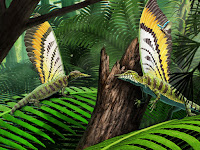 |
| Mirasaura grauvogeli Spiekman, Foth, Rossi, Martín, Slater, Enright, Dollman, Serafini, Seegis, Grauvogel-Stamm, McNamara, Sues & Schoch, 2025 |
Abstract
Complex integumentary appendages such as avian feathers and mammalian hair play a principal role in tetrapod evolution, with critical functions in insulation, sensation, display and flight. Although feathers and hair originated in the stem-lineages of birds and mammals, respectively, their underlying gene regulatory network has much deeper amniote roots. The early evolution of amniote integumentary appendages, however, remains poorly understood because of the absence of fossil evidence. Here we present Mirasaura grauvogeli, a small-sized diapsid from the Middle Triassic epoch (about 247 million years ago) with a distinctive crest formed by elongate integumentary appendages extending serially along its back, similar to those of the poorly understood Triassic reptile Longisquama. Despite its superficially bird-like skull, Mirasaura is not closely related to avemetatarsalians but instead belongs to the exclusively Triassic reptilian clade Drepanosauromorpha. Melanosomes preserved in its integumentary appendages are consistent in geometry with melanosomes of feathers but not those of reptilian skin or mammalian hair. Nevertheless, the morphology of the integumentary appendages and phylogenetic placement of Mirasaura indicate that they are not structurally homologous to feathers or other integumentary appendages in living amniotes. Our findings show that complex integumentary appendages are not restricted to avemetatarsalians and mammaliaforms among amniotes and evolved in a lineage basal to all extant reptiles, challenging our understanding of the evolution of the reptilian integument.
Systematic palaeontology
Diapsida Osborn, 1903
Drepanosauromorpha Renesto, Spielmann, Lucas & Spagnoli, 2010
Mirasaura grauvogeli gen. et sp. nov.
Etymology. mirus (Latin): wonderful or marvellous; saura (Latin): reptile. The species name honours Louis Grauvogel, who extensively excavated the Grès à Voltzia localities and discovered Mirasaura.
Holotype. SMNS 97278 (Staatliches Museum für Naturkunde Stuttgart, Germany), an articulated skull and poorly preserved postcranium, including a largely complete crest.
Locality and horizon. Lower unit (Grès à meules) of the Grès à Voltzia Formation (early Anisian, early Middle Triassic), Vosges mountains, eastern France, (see Supplementary Information for geological context).
Diagnosis. Mirasaura grauvogeli is a drepanosauromorph distinguished by the following combination of character states (autapomorphies among non-saurian diapsids are marked with an asterisk*): elongate integumentary appendages extending dorsally from the anterior part of the trunk; long, narrow snout; dome-like skull roof; anterior portions of the jaws completely edentulous*; dorsoventrally low maxilla; frontal strongly constricted anteriorly; forward-facing orbits; transversely wide parietal; elongate, barrel-shaped trunk; seven cervical vertebrae; 24 dorsal vertebrae*; hypapophyses on cervical vertebrae; cervical ribs and gastralia absent; moderately elongate caudal haemal spines; narrow and elongate scapular blade; carpals lacking proximal elongation; ilium with tall, anterodorsally oriented blade; and large, curved pedal unguals.
Stephan N. F. Spiekman, Christian Foth, Valentina Rossi, Cristina Gascó Martín, Tiffany S. Slater, Orla G. Bath Enright, Kathleen N. Dollman, Giovanni Serafini, Dieter Seegis, Léa Grauvogel-Stamm, Maria E. McNamara, Hans-Dieter Sues and Rainer R. Schoch. 2025. Triassic Diapsid shows early Diversification of Skin Appendages in Reptiles. Nature. DOI: doi.org/10.1038/s41586-025-09167-9 [23 July 2025]



